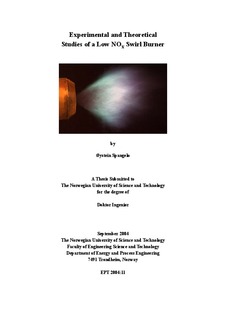| dc.description.abstract | Nitrogen oxides emitted to the atmosphere can cause health problems for humans and environmental problems such as acid rain and global warming. The main part of the world energy consumption involves combustion; hence nitrogen oxide abatement in combustion is an important research field. Formation and reduction of NOx in combustion and the current regulations on NOx emissions are reviewed.
A novel low NOx swirl stabilized gas burner concept, the Swirl Burner, has been studied experimentally, theoretically and numerically. Flame stabilization, rapid air and fuel mixing and internal flue gas recirculation are provided by a strongly swirling flow generated in this patented burner concept. NOx emissions have been measured below 25 and 45 ppmv dry corrected to 3% O2 in the flue gases using methane and propane as fuel respectively.
Studying the effect of varying geometrical parameters on the emissions of NOx, fuel and air supply pressure and flame stability, have resulted in an optimized burner design. The optimized Swirl Burner has successfully been scaled from a 200 kW burner down to a 20 kW burner and up to a 370 kW burner, using a constant velocity scaling criteria which is the most commonly used scaling criteria for industrial burners. Experiments with the scaled burners have revealed that the fuel to air momentum should be preserved while scaling the burner. The 200 kW and the 370 kW burners were operated stable with the boiler to burner diameter (confinement) ratio in the range 5.3-6.7. The 20 kW burner, which was operated in an un-cooled and a water-cooled combustion chamber with confinement ratio of 8.1, was found to have a narrower range of stable operation with regards to thermal throughput. High post-flame heat extraction, which is enhanced by increased confinement ratio and combustion chamber cooling, reduces the emissions of NOx, but might cause flame instabilities.
NOx emissions measured from the three Swirl Burners scale well with NOx scaling correlations based on flame volume as a leading-order parameter for NOx formation (Weber, 1996). The correlations consider the effect of heat extraction on flame volume and emissions of NOx. These correlations indicate that the heat extraction from the 20 kW burner is increasing with increasing thermal throughput. The 200 kW and the 370 kW burners were, from the correlations, found to operate with constant heat extraction.
Flame volume and shape are studied by non-intrusive measurements of OH radicals with the 20 kW burner using laser induced fluorescence. The measurements show that the flame volume is reduced with increasing thermal throughput. Measurements of NOx from this burner also show a reduction with increasing thermal throughput. These results support the theoretical considerations of the flame volume as being the leading-order parameter for NOx formation.
An evaluation of turbulence models and combustion models suitable for studying the Swirl Burner by computational fluid dynamics has been carried out. For this evaluation, a 2D computational model of the 20 kW burner has been used. For closure of the Reynolds Averaged Navier-Stokes equations for turbulent flow, three models have been evaluated.
These are the standard k-ε model, the RNG k-ε model and the Reynolds Stress model.
Also for modelling of combustion, three models have been evaluated, namely the Eddy Dissipation model, the Equilibrium PDF model and the Flamelet PDF model. For studying the Swirl Burner, a combination of the Reynolds Stress model and the Flamelet PDF model were found to be most suitable for modelling of turbulence and combustion respectively.
Computational results with the 20 kW burner indicate that flue gases are recirculated into a central toroidal recirculation zone downstream the burner exit. The computations are further compared with the OH concentrations measured with laser induced fluorescence. | nb_NO |
